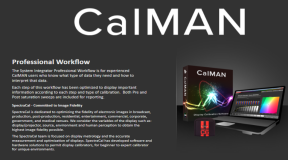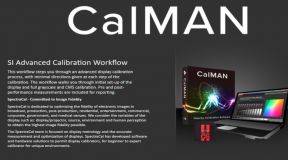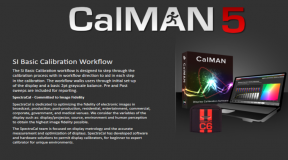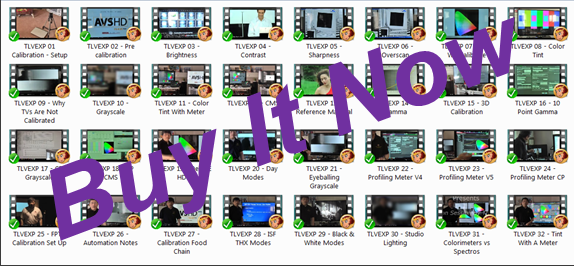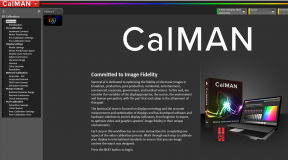Walkthrough to Demonstration DVD #18
As of the beginning of June 2006, this “Version 18” is now my latest and most up to date demonstration that I use to test both the image and TV performance following a typical ISF(THX) calibration session. Consider this a reference demonstration source to verify that any apparent image issues with other source material is strictly related to source material and not the elements of the calibration session. This scenes function as my calibration sanity check program. It is one thing to sit and look at test patterns, but in the end, you have to look at real material and this is it. There have been a few occasions where a calibration seemed to go well on paper, but something popped up on this demo telling me that all might not be as right as I thought. Double checking is always a good thing.
Title 1: Panasonic Demonstration – Jewelry
| Dolby Pro Logic | Focus On
Highly detailed items to demonstrate image sharpness Color Saturation Video Graphics on Film Women |
|
| Comments:Manufacturer demonstration discs tend to always focus on things that are highly detailed and images that are nice and bright. Either small objects or scenic locations are always highlighted. These discs also focus on one other item. Women. The TV companies know exactly who they are marketing their products to and it is not women. You will rarely see men in these demonstration videos. The moving Panasonic logo also tests for proper de-interlacing of the image with a mix of film text and video text. The opening test with the girl sitting on the beach is a test for the red chroma bug. Look at the red coloured letters to see if they are jaggie.
|
||
Title 2-6: DVD Benchmark
| Dolby Digital 5.1 | Focus On
De-Interlacing Detail Jaggies Video Text On Film
|
|
| Comments:From the DVD Benchmark disc, these tests identify processing deficiencies in DVD players and or TV sets depending on how the signals are being sent to the TV. If you send 480i to the set, then it tests the TV. Otherwise it tests the DVD player de-interlacing capabilities. The up converting LG players with Faroudja processing tend to pass all the tests. Units without this processing tend to fail. Denon and Panasonic and Marantz upconverting players tend to pass these tests, but Marantz has issues with the film detail test with the racing car. Toshiba and JVC and Pioneer tend to fail. I kept the Jaggie test, the second Jaggie test and the flag test. Three tests that check the same thing. The detail test looks at the fine details like in the grass and the rocks in the stone bridge structure. The opening test pattern test effectively tells us whether the DVD player is going to pass this one. The racing car pattern for film material is the second to last test. The graphics on film is the final test. The Panasonic demos on the disc also test this same effect. I expect that a person can go through and properly evaluate a DVD player in well under five minutes once they are familiar with the patterns.
|
||
Title 7-11: Monster ISF Calibration Scenes
| Dolby Pro Logic 2.0 | Focus On
Brightness Contrast Color Tint Sharpness Geometry / Overscan |
|
| Comments:From the Monster Cable/ISF HD calibration disc distributed at the Las Vegas ISF Seminar in January 2006, these test scenes are a very easy walk through narrated by singer Jenna Drey. The source is the Jenna Drey’s Easy To Use HDTV Calibration Wizard created by Joel Silver of the ISF at Microsoft Studios in conjunction with Monster Cables which distributes the disc. It took Joel two years to get these patterns to DVD. The narration for the sequences are very straight forward and help the user set up brightness and contrast and color levels and sharpness based on real life examples rather than test patterns. The examples, though, are actually a clever way to disguise test patterns. In many ways, the contrast test here with the man in the white shirt is one of the best ways to determine proper contrast levels. It excels beyond what test discs have been able to provide up to now. The shirt detail contains a lot of above white material that is desirable to retain, although not officially required for proper image set up. The extra details provide for image headroom on the bright end.
|
||
Title 12: Bring It On
| Dolby Digital 5.1 | Focus On
Color Saturation Tint Red Push Chroma Upsampling Error Lens Striping |
|
| Comments:There is a lot to see in this opening sequence from the film. This is the first test for colour saturation and tint following the typical eyeballing of these two controls after we determine that the color filters are ineffective on certain sets. The red/orange uniforms are a great to show if there is red push going on with the display. If there is, then the outfits will glow red and usually over power the entire image. (Over emphasis of the colour red by the colour decoder.) If there is a chroma bug (CUE) in the DVD player, then it will show up here in the red material as jaggies on the edges. The effectiveness of lens striping on RPTV’s can also be seen here as many of the characters move across the screen from edge to edge. Without proper lens striping, we will actually see their flesh tones change colour as they move across the screen.
|
||
Title 13: Fifth Element (Superbit Version)
| DTS | Focus On
White Crush Black Crush Red Push Gamma
|
|
| Comments:There are two primary things to look at here besides Leeloo. The waiter/mangalore entering the room at the beginning of the segment wears a white jacket and if the contrast is set too high, the detail in the jacket can be completely washed out in a sea of bright white. This effect is known as white crush. Easiest seen on digital displays like LCD and DLP as opposed to CRT sets where you will still see the shirt details even at high contrast settings. Later in the scene we are looking at black detail as people in the audience listening to the Diva, are wearing plenty of black material. Leeloo’s orange costume also will show red push in the set if it is present. The outfit will literally start to glow in this scene making it look unnatural. In some cased when the gamma is not so great in the TV, the mid range of the image becomes a little too bright while the black bars at the top and bottom of the screen still stay black.
|
||
Title 14: Chicago
| DTS | Focus On
Black Detail |
|
| Comments:This is a great test for digital displays and how they can and cannot display blacks even if their lives depend on it. On some DLP units, there is absolutely no detail in the dark areas as significant levels of black crush are occurring. Things slightly above video black are all assigned the value of black hence much low level detail is completely lost. There is a lot of black detail to be seen in this clip, and we don’t want to see great big blobs of black in the scene.
|
||
Title 15: Star Trek Insurrection
| Dolby Digital 5.1 | Focus On
3:2 Inverse Telecine
How 24 Frames become 30 Frames. |
|
| Comments:This one is the famous test to see how the TV and/or the DVD player in question handles the 3:2 pull down process where film is converted to video going from 24 frames per second up to 30 frames per second. Poor conversion or no 3:2 will result in lots of jaggies along any diagonal edge in the sequence. The bridge railing and the canoes on the shore are things to keep an eye on. The roof tops and the children playing on a bridge on the top of the screen are more examples of the process. When done correctly, the items in these scenes should not stand out as being artificial looking. The opening of the scene with the children playing in the haystack is also another demonstration of the same thing. The hay is either fairly smooth or there will be a lot of unwanted movement in the hay itself.
The panning sequence across the village is here to also demonstrate what happens when we convert 24 film frames to 30 video frames. The pan is supposed to be a smooth one, but as we look closely, we see that it actually jerks along. The image speeds up and then slows down and then speeds up and slows down … at every slow down point, one film frame is being repeated … and this happens six times every second … so 24 + 6 = 30 video frames.
|
||
Title 16: Titanic
| Dolby Digital 5.1 | Focus On
4:3 Non Anamorphic Widescreen Material
Zooming and Scaling |
|
| Comments:This one is here to test out how the DVD player and/or the TV handles a 4:3 formatted widescreen film. Will the DVD player zoom the image or scale it to fit into the 16:9 frame? If not the DVD player, then how does the TV handle this process and is it better than what the DVD player can do? We look for jagged edges along the ships diagonal wires.
|
||
Title 17: King Kong
| Dolby Digital 5.1 | Focus On
Solarization Posterization Bit Depth Color Wheel Issues |
|
| Comments:Taken from King Kong, the clip is here to look for solarization and posterization effects created on the display end when there are problems with the DLP color wheel setting or when there is a lack of bit depth in the display. Many second tier plasma sets and other technologies will display the multilayered fog effects as step patterns rather than a smooth transition. Often depressing to highlight, it is still good to know that a problem is there. The best way to look at this type of test is from a color perspective. A display may be capable of displaying 16 million colors, but on the dark and or near dark end of the image, the color choices drop considerably down to an effective 256 colors. It is this lack of available color choices that turns smooth transitions into step patterns or worse.
|
||
Title 18: Sony Demonstration – Canadian Reflections 1
| Dolby Pro Logic | Focus On
Details |
|
| Comments:The clip is from a Sony demonstration disc. It shows fine nature shots from sites throughout Canada. Nature clips are always there to impress people and are one of the three primary things that TV makers put into their demonstration material. While nice looking, I am not always convinced that this material can be used as a real life reference. It’s still hard to tell just what colour the snail should be or the mountain lake or the flowers.
|
||
Title 19: Toy Story
| Dolby Digital 5.1
|
Focus On
Red Chroma Bug Red Push |
|
| Comments:This is the test for the chroma bug or the up conversion error (CUE). This clip will also show the effects of red push given the heavy reds in the sequence. The tinkertoy lid would be full of jagged edges if the CUE is present. Also take a close look at Woody’s microphone as he swings it around to see the wavy distortion in the red colour. The reds would glow here if the colour decoder is improperly set up. Stores like to use CGI based programs like this and Finding Nemo and Monsters, Inc. and others because the material is very sharp, but also to hide any problems with colors. The material is not based on real life and can even hide grossly inaccurate color on TV sets.
|
||
Title 20: Down With Love
| Dolby Digital 5.1 | Focus On
Red Chroma Bug Red Push Video Material Test 4:3 Material Black Level Test |
|
| Comments:This is a 4:3 aspect ratio test to see how the TV or DVD player handles this material. The red dress is here to show red push as well as the red chroma bug (CUE). As an original video based music video, the sequence might trick some TV’s or DVD units into applying 3:2 pull down on the clip making it look more jagged than it should be. The TV or the player should catch it and stop the pull down process eventually. This clip is also very helpful at demonstrating the effects of Faroudja processing of video based material. Without this processing, artifacts will be seen on dress and other places through out the sequence that look like jaggies. Some scenes here are much sharper than others which might be an indication of them using video cameras of varying quality. The black suit that Ewan is wearing is also a test for black detail. I enjoy hearing both these two actors sing.
|
||
Title 21: Panasonic Demonstration – Bond
| Dolby Pro Logic | Focus On
Video/Film Transition Improper flags
|
|
| Comments:This is a 4:3 aspect ratio test to see how the TV or DVD player handles this material. As the sequence continues, there is a constant transition between film and video material so it tests to see how fast the TV or the player can keep up with the changes. The flags are also wrong on this clip so the player will have to figure out what is video and what is film. There are excessive jagged edges when the player or the display guesses wrong. Keep your eyes on the Panasonic logo as it moves across the screen. When reaction time is slow, the words have a jagged look to them as they move. The Bond girls are not too displeasing to the eye as well.
|
||
Title 22: Attack of the Clones
| Dolby Digital 5.1 | Focus On
Red Push Black Detail CUE |
|
| Comments:This scene is used to demonstrate how incorrect we can be when we think that the space in a space film like this actually represents something like real black. A close examination of the blackness in the starfield reveal that the starfield is actually brighter than the black bars on the top and bottom of the picture. Don’t use space films to try to demonstrate absolute video black. The quick shots of things that are red would highlight the red push done by the TV and the CUE where applicable.
|
||
Title 23: For Love of the Game
| Dolby Digital 5.1 | Focus On
Red Push Black Levels |
|
| Comments:In this scene, we look to the Detroit Tiger “D” on the cap and the subtle differences between the black cap and the navy blue shirt. The sequence ends with the black detail test as Kelly Preston is wearing a black sweater, black coat and a black purse. The briefcase is brown. She is either a large mass of black where we can see no details at all or each shade of black is clearly delineated without the black bars on the top and bottom being washed out.
|
||
Title 24: Jurassic Park III
| Dolby Digital 5.1 | Focus On
3:2 Pulldown |
|
| Comments:The subtle shift of the airplane wing is all I am looking at in this scene. It is a test for the 3:2 pulldown. Does the TV do a better job than the DVD player? Here is the test. Joel uses this at the ISF seminars.
|
||
Title 25: Shakespeare In Love
| Dolby Digital 5.1 | Focus On
Detail |
|
| Comments:Here is my detail test. I always pause on Rupert Everett’s face because of all the detail that is there. This is a very good disc for detail so we look for weaknesses on the TV end or the DVD end. What is and is not being shown in this section? Is 540P upconversion on the set a problem? Look here. This used to be a very effective way of pointing out the Toshiba RPTV’s problem with their 540P upconversion when they first introduced that feature. We look at the face and the hair and then we move to the beard and the pot marks in the face. It should be noted that if we didn’t know we were missing any particular details like beard stubble, would it really diminish our enjoyment of the film? Of course not. It is still nice to know that we are seeing all the DVD has to offer though.
|
||
Title 26: Blade
| Dolby Digital 5.1 | Focus On
Black Level Test Perception of Black
|
|
| Comments:This scene serves a few purposes. It starts off as a demonstration of how our perception of colour changes depending on the overall lighting and environment. We look at Blade’s black outfit which looks distinctly blue in the cold urban landscape, but once he enters the park, his outfit looks warmer if not a touch green. Next up is a black level test as we want to be able to see Blade’s eyes from behind his sun glasses in the medium shots. We get to see the whites of the eyes behind the glasses.
|
||
Title 27: Moulin Rouge!
| DTS | Focus On
Red Push Test CUE Test Black Level Test |
|
| Comments:The dark nature of this scene makes it a black level challenge for many displays especially digital ones. The red of her dress and lips are there to demonstrate red push and the CUE. I am also extremely fond of the love song medley that they sing. There are also some fine details and the look of the black tuxedo in this lighting.
|
||
Title 28: Boz Scaggs Greatest Hits Live
| Dolby Digital 5.1DTS
Pro Logic
|
Focus On
Colour Saturation Black Detail |
|
| Comments:This is a nice looking concert DVD shot with HD cameras and converted to DVD. We are looking at the warm image and the black detail in the shadows.
|
||
Title 29: Brotherhood Of The Wolf
| Dolby Digital 5.1 | Focus On
Weakness of MPEG encoding process |
|
| Comments:Aside from a generally cool audio track, I included the French DTS track instead of the English one. The scene was chosen to demonstrate what too much movement in the scene does to the image. MPEG2 gets its encoding weakness revealed because there is too much rain making the rain have a digital look.
|
||
Title 30: Hero
| Dolby Digital 5.1 | Focus On
Red Push CUE
|
|
| Comments:This clip is taken from the Asian import version of the film rather than from the general North American issue which many were disappointed in to some degree. This one is generally a test for red push and the chroma bug. Watch right to the end of the sequence to see the entire sea of leaves go red. This is an extreme red push test.
|
||
Title 31: Panasonic Demonstration – Fashion
| Dolby Pro Logic | Focus On
Details
Color Saturation
Women |
|
| Comments:Yet another nice looking video clip from a Panasonic demonstration disc. Women and fine details are once again the order of the day.
|
||

